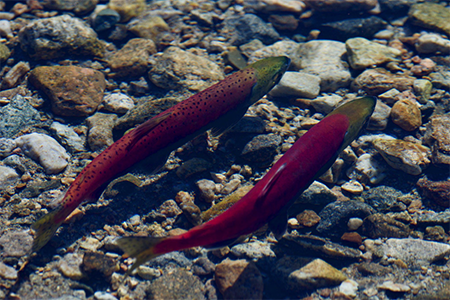BY LARRY BARNES
When it is finally warm at Redfish Lake and beach-goer populations peak, a nearby annual display of nature’s extravagance goes mostly unnoticed. In the shallows of Fishhook Creek the kokanee salmon (Oncorhynchus nerka) gather to pass the baton to the next generation. Thousands may assemble in a free market of cortisol and oxytocin, anxiety and sex, in an all-or-nothing race to beat the clock, the predators, and the competitors toward the goal of moving kokanee genes into the future.
If you follow a sinuous boardwalk tortured by winter snows, freezes, thaw cycles and UV light, you will find the kokanee breeding grounds. Here, amidst willow tangles and a high water table, the kokanee commit the end of their lives to reproduction. Self-preservation fades and their bodies adopt a Christmas-color theme – red with green heads. They are easy targets now for ospreys and eagles, but, like a million wildebeest synchronously giving birth on the Serengeti, predators can only eat so much.
Looking down at their lythe bodies through a fluid prism, the kokanee reveal a part of their lives. Nature compels the females to build redds into the gravel, depressions they dig with spirited movements of their tail. A male, seeing or sensing a female depositing about a thousand eggs into her redd, then releases the milt bearing his sperm, which settles in a white cloud over their joint futures.
To the kokanee, these events must be charged with fishy drama. The kokanee spent the previous four years in Redfish Lake, feeding on plankton at depth in a nutrient-poor environment. For roughly 20 months of this time, ice capped their world and metabolism was glacially slow. As a result, the Redfish Lake kokanee reach only about 12 inches. The kokanee’s big brothers, the ocean-going sockeyes (also Oncorhynchus nerka), are much larger, thanks to the sea’s superabundance of food.
In the season of human beach bathing, the annual kokanee cohort moves into high gear, burning through the reserves of the previous four years. Males and females chase each other about, vying for mates and redds. Some females, having seized a good redd site, hover over it, aggressively chasing away competitors. Meanwhile, a few yards away, in deeper water, spheres of 100-200 fish mix amicably, as if waiting their turn to enter the redd-finding, mate-finding fray. It could be that they are staging for the hormonal transformation that terminally leads to their ultimate purpose.
The water flowing smoothly over the kokanees’ bodies mirrors the energy passing through them. It began with packets of light from the sun that powered the plants that funded the food chain that built these red-and-green marvels beneath the boardwalk. And now liquidation time is here. All kokanee will die. Some abruptly via talons or teeth, but most by running their metabolisms into the ground. The females will defend their eggs nestled within the right-sized gravel of their redds. The males will fight to fertilize one final mass of eggs. Fungi and bacteria will deliver the coup de grâce and reduce the parent bodies into their elemental forms – nutrient care packages for future generations. After four more orbits of our tilted Earth around the sun, a new generation of kokanee will rendezvous in Fishhook Creek and follow their ancestors in the pursuit of immortality.
Larry Barnes retired from 26 years as a biology teacher at Wood River High School and is now transitioning to spending more time exploring the natural world.



